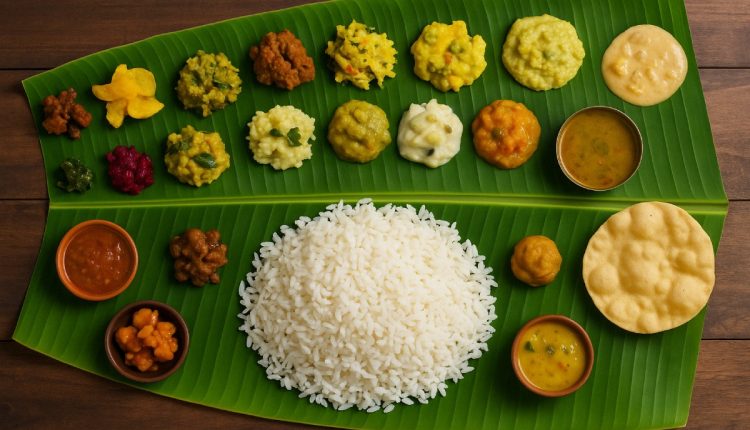In the heart of Kerala’s vibrant culture lies a culinary tradition that is both a sensory delight and a spiritual experience—the Kerala Sadya. Served on a fresh banana leaf, this lavish vegetarian feast is a celebration of life, nature, and unity. Rich in flavors, colors, textures, and symbolism, Sadya is not just a meal; it’s a ritual that speaks volumes about the region’s philosophy of balance and harmony.
Whether it’s Onam, Vishu, a temple festival, or a wedding, no celebration in Kerala is complete without a Sadya.
What is a Sadya?
The word Sadya in Malayalam translates to “banquet” or “feast.” True to its name, a Sadya is a multi-course meal that features a wide array of traditional vegetarian dishes—sometimes exceeding 25 to 30 items—all beautifully arranged on a banana leaf.
Served typically at lunchtime, Sadya is meant to be eaten by hand while seated cross-legged on the floor, a posture believed to enhance digestion and mindfulness during the meal.
The meal follows a specific layout and order—every item has its designated place on the leaf, and the sequence in which it is served and consumed holds cultural significance.
A Symphony of Dishes: What’s in a Traditional Sadya?
Here are some of the must-have elements of a classic Sadya:
1. Rice (Choru)
The foundation of the meal, typically red matta rice, is served in generous portions. It’s soft, earthy, and holds up well to the liquid curries and side dishes.
2. Parippu
This is a simple moong dal curry served with ghee. It is usually the first dish poured over rice after the accompaniments are served.
3. Sambar
A hearty lentil and mixed vegetable stew spiced with tamarind and sambar powder. It adds warmth and depth to the meal.
4. Avial
A thick medley of vegetables cooked in coconut and yogurt, seasoned with curry leaves and coconut oil. It’s considered the soul of Sadya.
5. Thoran
A dry vegetable dish, finely chopped and stir-fried with grated coconut, mustard seeds, and turmeric.
6. Olan
A subtle dish made with ash gourd, cowpeas, and coconut milk. It’s mildly spiced and soothing to the palate.
7. Kaalan
Made with raw banana or yam, cooked in yogurt and coconut paste, then tempered with black pepper and curry leaves.
8. Pachadi and Kichadi
These are yogurt-based condiments. Pachadi may include fruits like pineapple or grapes, while Kichadi typically features cucumber or bitter gourd.
9. Rasam
A tangy, spicy broth made with tamarind, tomato, and black pepper. It’s light and acts as a palate cleanser.
10. Pappadam
Crunchy lentil wafers that are crushed over rice or eaten as is. They add an irresistible texture to the meal.
11. Banana Chips & Sharkara Varatti
No Sadya is complete without these. The salted banana chips provide crunch, while the sweet jaggery-coated chips offer a contrast in flavor.
12. Pickles (Achar)
Usually includes lime, mango, or ginger pickles. These add a punch of heat and tang.
Sweet Endings: The Payasam Trio
A Sadya usually concludes with payasam, a luscious dessert made with lentils, rice, or vermicelli, cooked in milk or coconut milk and sweetened with jaggery.
Popular payasam types served during Sadya include:
-
Palada Payasam – milk and rice flakes, sweet and creamy
-
Ada Pradhaman – jaggery-based payasam with rice ada and coconut milk
-
Parippu Payasam – made with moong dal and jaggery
Some Sadya meals may serve two or even three types of payasam as a finale!
A Meal with Meaning
Beyond flavors and textures, Sadya embodies the philosophy of Ayurveda—a balance between taste, health, and well-being. It is designed to include all six tastes: sweet, sour, salty, bitter, pungent, and astringent.
Each dish contributes not just to the culinary experience but also to nutritional balance and digestive health.
Why Sadya Is More Than Just Food
-
Cultural Ritual: Sadya reflects the communal spirit of Kerala. Whether it’s a temple celebration or a wedding, it brings people together in a shared space of gratitude.
-
Eco-Friendly: Traditionally, it’s served on banana leaves, which are biodegradable and add a subtle aroma to the food.
-
Mindful Eating: Eating with hands and in silence encourages connection with food and body awareness.
-
Seasonal Ingredients: Most dishes use locally grown vegetables and seasonal produce, which aligns with sustainable and healthy eating.
Where to Experience an Authentic Sadya
You can savor authentic Sadya in:
-
Kerala households during Onam or Vishu
-
Temple festivals (like Aranmula or Thrissur Pooram)
-
Specialty Kerala restaurants like Bharat Hotel (BTH), Kochi, or Sree Krishna Inn, Guruvayur
-
Onam food festivals across India and abroad
Final Thoughts: A Soulful Feast
Kerala Sadya is more than just a feast—it’s a sensory journey, a reflection of culture, tradition, and the timeless art of balance. With its meticulously prepared dishes, it not only pleases the palate but also calms the mind and nourishes the soul.
So, the next time you’re invited to a Sadya or visit Kerala during Onam, take a moment to truly appreciate the banana leaf in front of you—it’s a piece of culinary heritage.


Comments are closed.